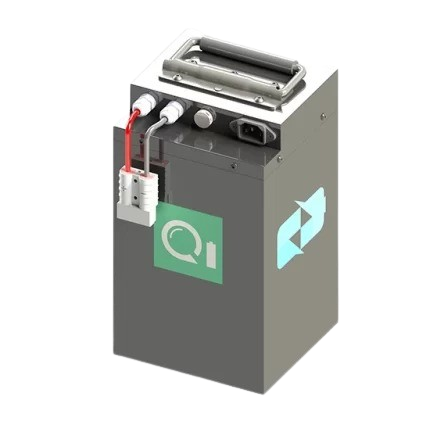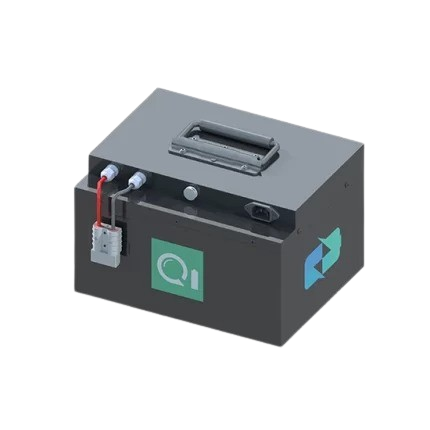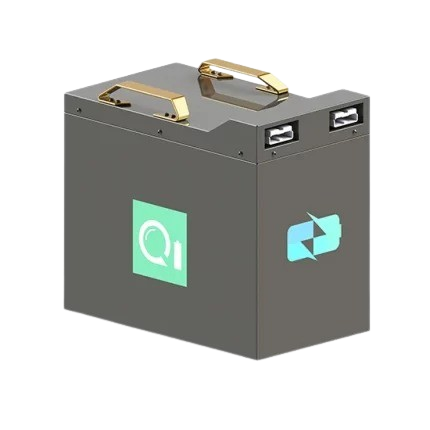


3 Wheeler Battery Packs
A three-wheeler battery pack refers to the battery system used to power electric three-wheeled vehicles, such as electric tricycles or auto-rickshaws. Similar to two-wheeler battery packs, these battery systems are typically composed of multiple lithium-ion cells connected together to provide the required voltage and capacity.
Voltage & Capacity
The voltage of a three-wheeler battery pack can vary depending on the specific model and power requirements. It is commonly in the range of 48V to 96V or even higher in some cases.
The capacity of the battery pack determines the driving range of the vehicle. It is usually measured in ampere-hours (Ah). Higher capacity batteries can provide longer distances on a single charge. As these vehicles have a higher load carrying capacity, Qmax makes batteries of 90Ah in this segment. be physically larger and heavier.
Battery Chemistry
Lithium Ion Phosphate (LFP) is the more commonly used type of batteries in three-wheeler battery packs as space is not a major constraint. Qmax also provides (Lithium Manganese Iron Phosphate) LMFP based solutions if required.
Vehicle Integration
Three-wheeler battery packs are designed to fit the specific requirements and constraints of the vehicle they power. Factors such as size, weight distribution, and mounting options are considered during the integration process.
Battery Management System (BMS)
Swappable Battery Systems
Some three-wheeled electric vehicles may utilize swappable battery systems, allowing for easy battery exchange to minimize charging time. This approach is particularly useful for fleet operators or in areas with limited charging infrastructure regulates the charging and discharging of the battery cells, ensuring optimal performance and safety.
Charging
Three-wheeler battery packs can be charged using standard electrical outlets or specialized charging stations. Charging times depend on the battery capacity and the charging infrastructure available. Qmax Ion batteries are capable of fast-charging within an hour. Fast-charging options are becoming more common, enabling quicker recharging.
It's important to note that the design and specifications of three-wheeler battery packs can vary between different vehicle models and manufacturers. Qmax Ion ensures to consult with the manufacturer to get the exact requirements, resulting in an optimized battery pack.
Why Qmax 3 Wheeler Batteries are preferred by customers
Long Life
Fast Charging
AIS 156 Compliance
| Battery Pack | 90 Ah (Nominal) |
|---|---|
| Rated Energy (0.2C, 100% DoD at 25°C) | 4.32 kWh (48 V) / 5.47 kWh (60 V) |
| Estimated Life (at 80% DoD ) | 2000 Cycles (70% capacity Retention at EOL) |
| Nominal Voltage | 48 (48) / 60.8 (60) Vdc |
| Charge Current | 15 A (Nominal) |
| Continous Discharge Current | Up to 90A |
| Peak Discharge Current | 180 A (for 10 sec) --- (To be configurable as per duty cycle) |
| Operating Temperature | 0°C to 45°C Charge and -10°C to 50°C discharge |
| Battery Pack | 105 Ah (Nominal) |
|---|---|
| Rated Energy (0.2C, 100% DoD at 25°C) | 5.04 kWh (48 V) / 6.38 kWh (60 V) |
| Estimated Life (at 80% DoD ) | 2000 Cycles (70% capacity Retention at EOL) |
| Nominal Voltage | 48 (48) / 60.8 (60) Vdc |
| Charge Current | 15 A (Nominal) |
| Continous Discharge Current | Up to 105A |
| Peak Discharge Current | 210 A (for 10 sec) --- (To be configurable as per duty cycle) |
| Operating Temperature | 0°C to 45°C Charge and -10°C to 50°C discharge |
| Battery Pack | 210 Ah (Nominal) |
|---|---|
| Rated Energy (0.2C, 100% DoD at 25°C) | 10.08 kWh (48 V) / 12.76 kWh (60 V) |
| Estimated Life (at 80% DoD ) | 2000 Cycles (70% capacity Retention at EOL) |
| Nominal Voltage | 48 (48) / 60.8 (60) Vdc |
| Charge Current | 40 A (Nominal) |
| Continous Discharge Current | Up to 105A |
| Peak Discharge Current | 210 A (for 10 sec) --- (To be configurable as per duty cycle) |
| Operating Temperature | 0°C to 45°C Charge and -10°C to 50°C discharge |
